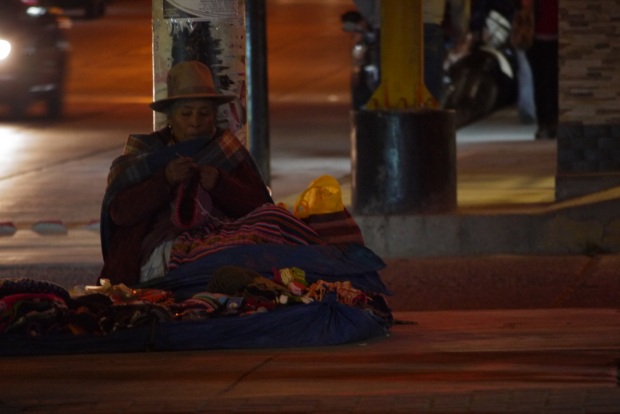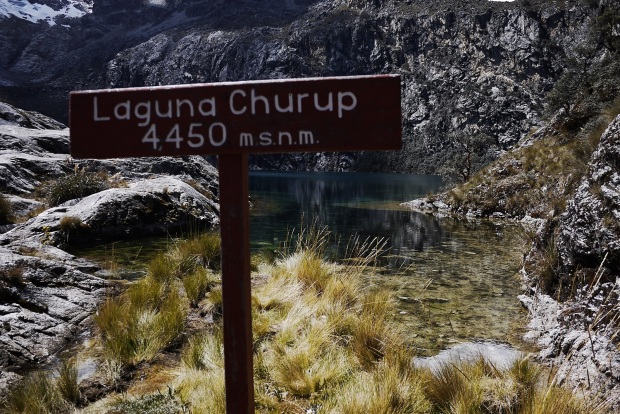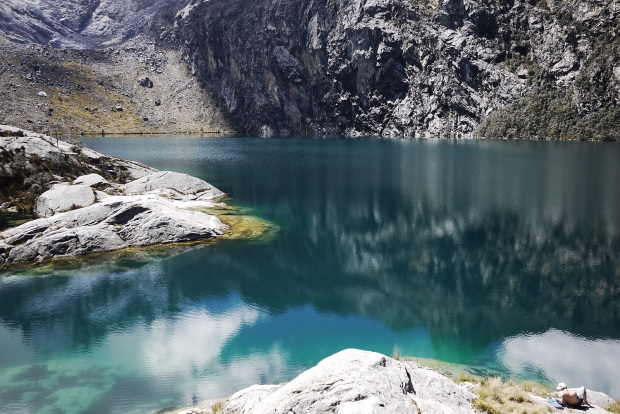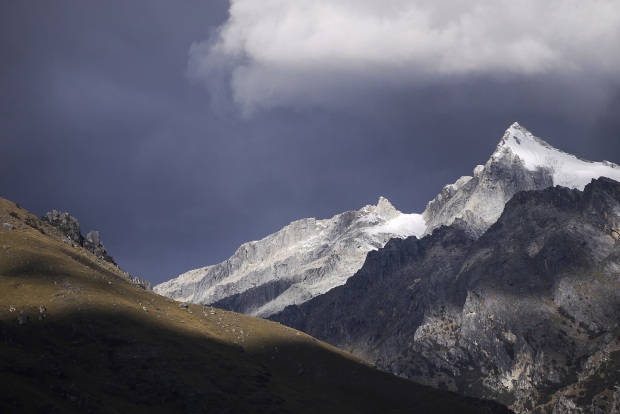“Oh wow, I think I’m gonna have to turn around”
Standing on the ridge of a 6000 meters high mountain is quite impressive. Looking right, nothing. Looking left, nothing either. There isn’t enough room on the path to fit both my right and left foot. The big yellow plastic boots tucked in crampons feel heavy. They are quite comfortable but my toes are chilled, despite the two layers of woollen socks. It is before 7am, the sun has just risen. We are 200m away from the summit of Huayna Potosi, one of the several 6000+m mountain surrounding La Paz in Bolivia.
“It’s too late to turn around” I get as an answer from Vincent, our Bolivian guide. “Come on, you made it up here, you can make it up to the summit!”
I am not sure whether those words come from my inner self, from Vincent or from Matthew. What I remember is that I was trapped in the middle of the two, roped up to both of them. For security purposes, you should be linked to each other with a rope so that if anyone falls in the crevasse of a glacier, hopefully your buddy can stop the fall. Hopefully.
Two months before that, I was meeting up with Matthew in Guayaquil in the south of Equador. Our idea was to spend time hiking down the Andes through Peru to Bolivia. I then spent some of the best weeks of my life, wandering around Peru, doing my first high altitude treks. We headed first towards the Cordillera Blanca region for a day hike to acclimatize and see how we were doing at higher altitude (Laguna Churup, 4450m) then to the gorgeous Huascaran National park for a week long hike (Laguna 69 and Santa Cruz, 4750m) followed by a couple of solo hikes to Larès (Sacred Valley, Cusco area, 4800m) and the remote Inca site of Choquequirao (3000m).
Why is acclimatization crucial? Because the higher you get, the less oxygen there is, the higher the risk of hypoxia (when your body lacks oxygen). What is high? According to wikipedia, altitude starts at 1500m and altitude sickness usually happens above 2400m. Hypoxia causes altitude sickness, whose symptoms commonly are headaches, pins and needles, shortness of breath, fatigue, lack of appetite, nausea, or dizziness. It doesn’t sound that bad but you can actually die if it gets to the point where it develops into a pulmonary or cerebral oedema. So you’d better take your time, don’t over-exhaust yourself and spend as much time as possible high enough so your body would adjust and get used to it.
Having spent so much time in the mountains before that hike and being naturally slow anyway, I haven’t felt much symptoms of altitude sickness. It is definitely harder to walk at higher altitude, you need to adjust your breathing and your pace.
As this was new to both of us, we decided to find an “easy” mountain, as they say. The more I climb the more I am aware there is no such thing.
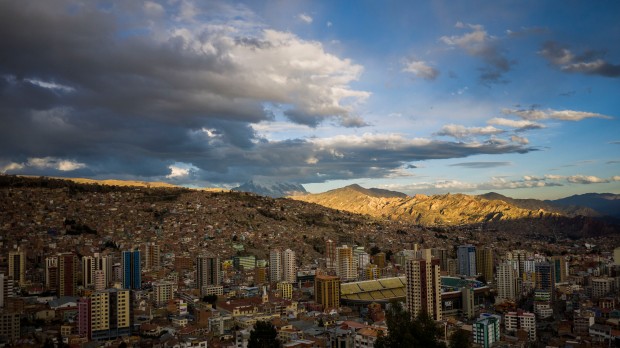
City of La Paz (3600m) with Mount Illimani (6438m) always somewhere in the background, here in the evening clouds
DAY 1
After a final equipment check, off we are. It’s a 2 hours drive, mostly to get out of La Paz and past El Alto (quite appropriately named as it is stretching above 4000m, home of the international airport which makes it one of the highest in the world). Shortly after El Alto, we cross that unreal village which used to be for miners working in the nearby mine (which is no longer in use since the 90s, as far as I know).

As we are approaching the mountain, the landscape is getting more and more gorgeous. Here is a lake whose colour has been largely affected by the nearby mine.
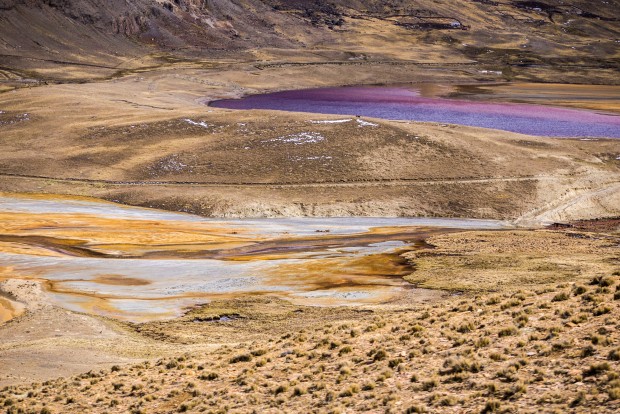
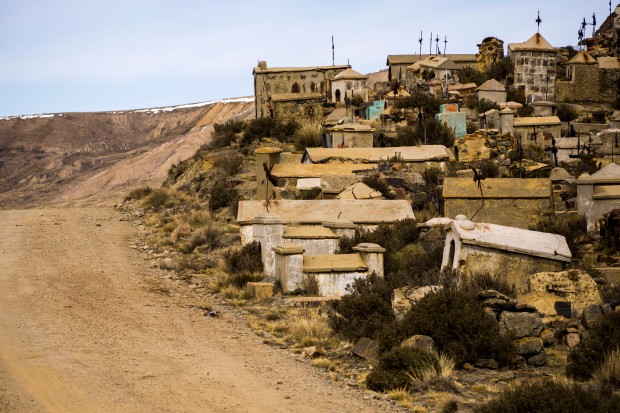
Passing by the old cemetery of Milluni
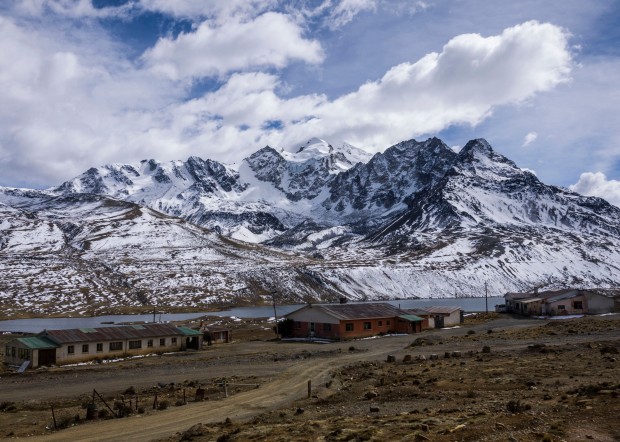
Old village of miners at the foot of Huayna Potosi.
We are driven to the first base camp at 4750m. It’s a basic house with some tables, a few mattresses on the floor and a pit toilet. Some people are already there, a group of French people (I know, they are everywhere!). Waiting for lunch to be ready, we go explore the area: a stunning glacier lake offering different views over the mountain we’re about to meet. As often in altitude, llamas are wandering around too.

Coming straight from glaciers, lake Zongo close to the first base camp.
Talking about lunch (and you’ll see, they is a link). If you are in La Paz right now, looking for an agency to go in the wild with, you are probably overwhelmed not knowing which one to chose. And you are right. Just trust your feeling, some agencies are quite dodgy (there were some groups that didn’t have enough food at all, which is a bit of a problem as your body burns more energy higher up and with the cold). After visiting a few, we chose Altitud 6000 Mountaineering Adventures. We had a good feeling after meeting them and they had plenty of good reviews online, for example mentioning how good the food was. It may seem futile but altitude tends to reduce appetite. If I don’t feel any sort of pain at higher altitude, I do feel that even if I get hungry, I don’t always feel like eating which is potentially dangerous. Not only our guide and his team were nice and professional but the equipment was good and the food delicious.
It is possible to climb Huayna Potosi in just 2 days, if you are well acclimatised and know how to use an ice axe. It isn’t technically that challenging (grade II/AD) with just two technical faces, the steepest reaching 55°. We did chose the 3 days option though, as it adds one afternoon of fun: learning the basic of ice climbing. It all happens at Glaciar Viejo where people are usually taken to practice. If you think rock climbing is fun, rest assured that ice climbing is even more fun.
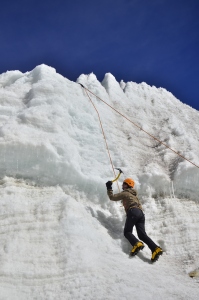
Yours truly in action (which is a strenuous one at 4850m!)
DAY2
After a good night of sleep (which is all relative as one of the effect of altitude is restless sleep and vivid dreams, which I experienced quite often during those 2 months), we’re off to the High camp at 5130m, to acclimatize and get ready for the summit attempt. Each step further up is getting more and more of a challenge but still ok. Half way up, it is getting steep and slippery and as we are carrying our bags, we need crampons.
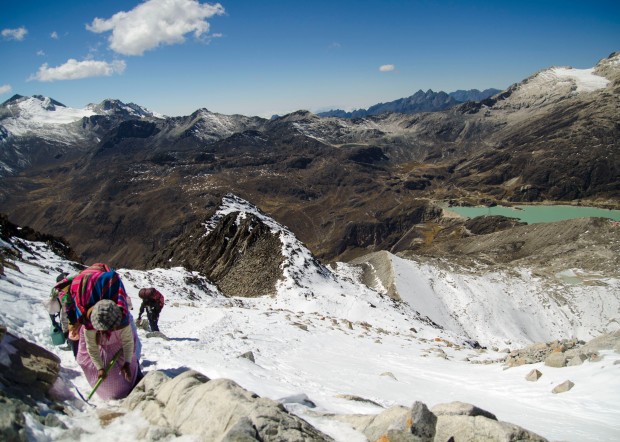
Although local women are still in sandals and dresses. (Photo courtesy of Matt)
It is just a 2 hours climb to get to the high camp but as the plan is to leave the camp at 1am to reach the summit for sunrise, we just rest and enjoy the landscape, eat an early dinner and try to fall asleep, even though it is still afternoon.

View from the High camp on one side
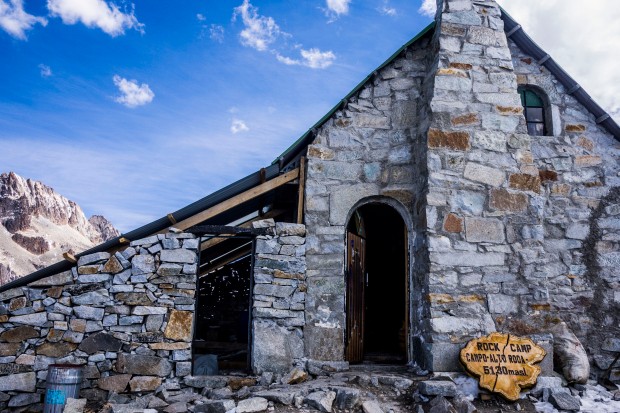
High camp, 5130m

Looking back to where we started (by the lake). The little house hosts the pit toilet.
DAY 3
It is midnight and little lights start moving around as people wake up and turn on their head torches. It’s unreal. I can hardly believe I’m going to be standing up on the summit in a few hours if all goes well. We mechanically dress up, one layer of wool after the other. A good breakfast made of cake and bread and coca tea and we’re off. Our guide Vincent leads, I’m second, Matt is third. We’re roped up to each other so we need to adjust the pace to one another. Or rather Vincent needs to adjust to our pace, which he does.
It is still unreal. There are a lot of people climbing tonight, about 20 (10 changed their mind last minute and stayed in the camp). It’s dark, there are billions of stars shining above us. Sometimes shooting stars that seems so big and so close. The moon is full, so we pretty quickly decide to turn our lights off and just use the reflection of the moonlight on the snow.
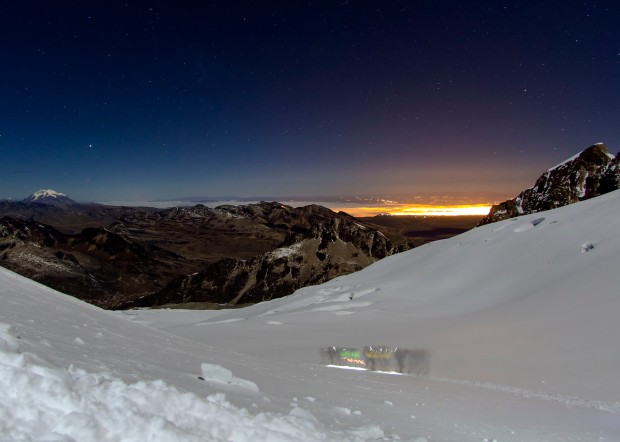
4am, looking back at a group of climber, the lights of La Paz shining in the background. (Long exposure shot courtesy of Matt)
The higher the more difficult it gets to just put one foot after the other. We need to stop to catch our breath. Even though the weather conditions are absolutely perfect (no wind, clear night), it is freezing and soon my feet, my hands and my nose feels numb. But we need to keep moving. I can’t be bothered to grab some chocolate out of my bag because it would take to long for my fingers to warm up. My nose is running. Ok I stop to blow it. Then we all have to stop. Matt is happy, it gives him a good reason to take a photo. I turn around, he’s all swaddled but I can see he’s smiling at me. Still no altitude sickness sign on my side but he confesses he starts to have stomach ache. Hopefully that’ll pass soon.
I am freezing. Light is finally starting to rise above the horizon. Yes! the sun is coming out soon to warm us up. It’s just before 7am when we get there:

No turning around possible at that point!
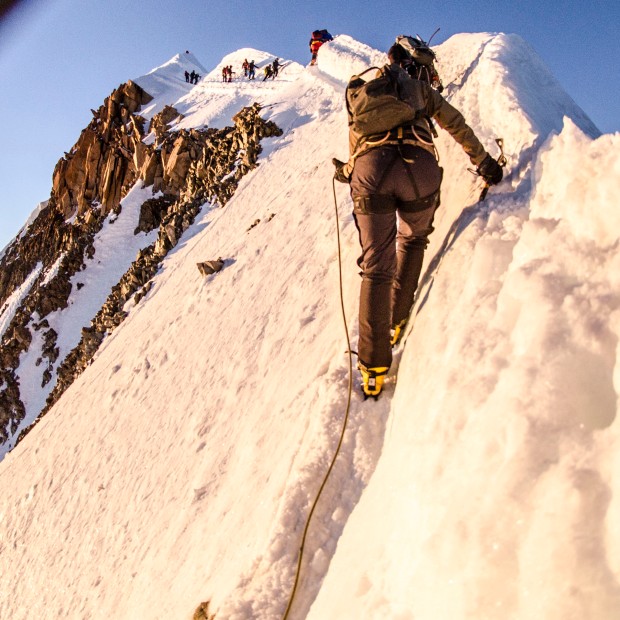
So I let people going down pass and carry on…Almost there!
So there, there isn’t enough room for both my feet to fit on the “trail”, but you can’t safely turn around (you would also have to wait for a small group to go down roped up to them for security reason). I suddenly realize where I am. The good thing is I’m not freezing anymore, way too concentrated on making sure that my crampons don’t get in the way making me stumble and focusing on breathing deeply in and out. I hold on as much as I can to ice axe, making sure it is safely hammered in the wall of ice and snow before I move on.
When suddenly:

Summit view, above the clouds
I can’t believe it, we made it! Emotions are running around my head, I am over the moon (or almost) but still terrified by the idea of making it down. But it is time to stop thinking, sit and enjoy. The clouds are running quite fast above the surrounding lower summits like water, it is stunningly beautiful and captivating to watch. A plane passes by and we point down at it, how weird to point down at a plane.
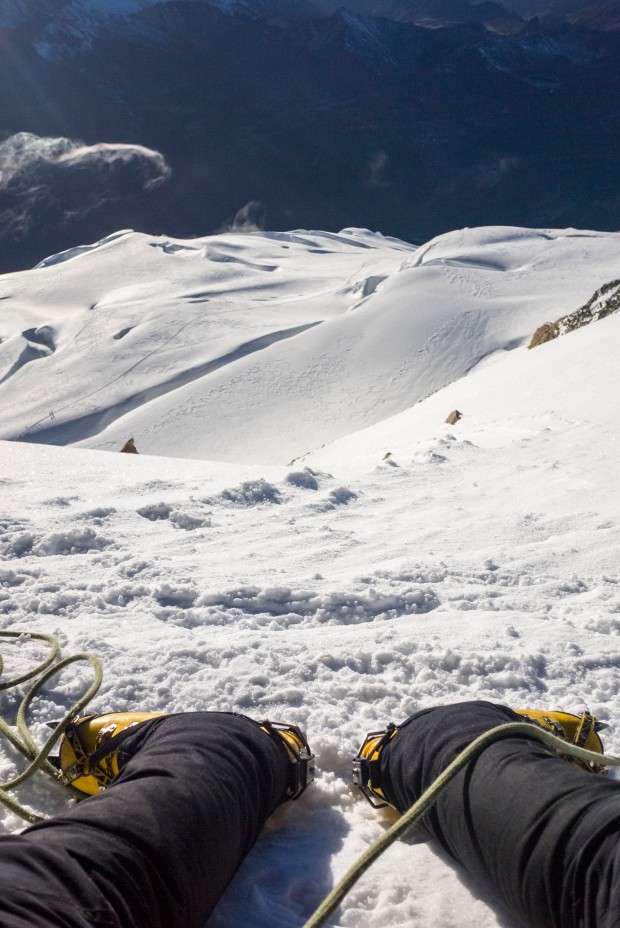
As I take my camera out of my bag, I focus on not dropping anything
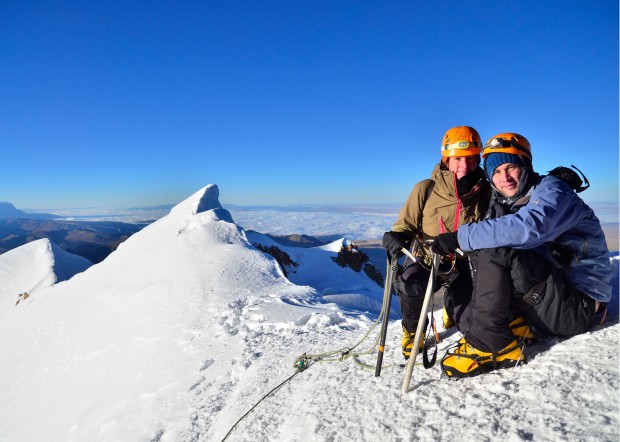
Happy summit photo!
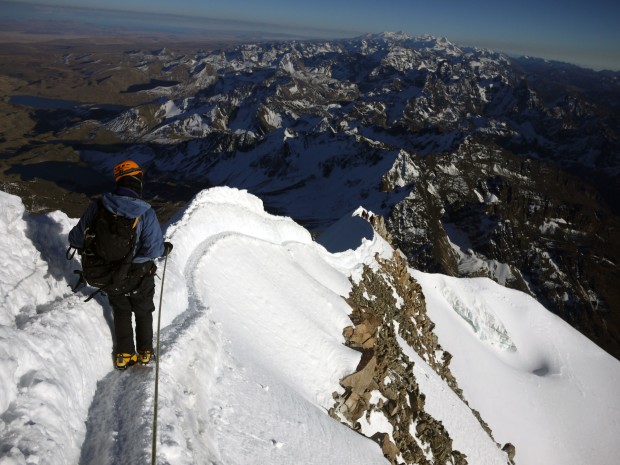
Time to go down
Going down was not much easier but much faster. As we climbed up at night-time, it was amazing to discover the same landscape under the sun and actually admire the gorgeous shapes of the mountains and glaciers.
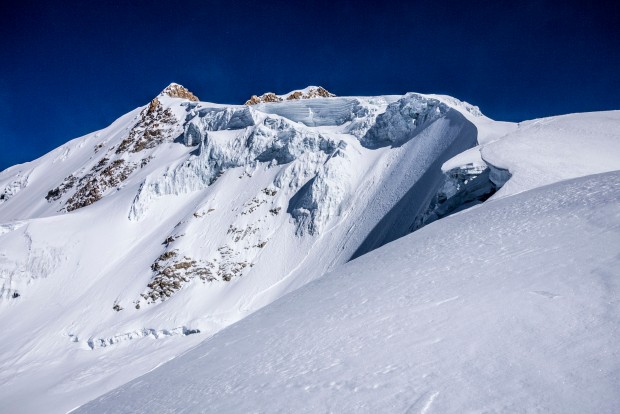
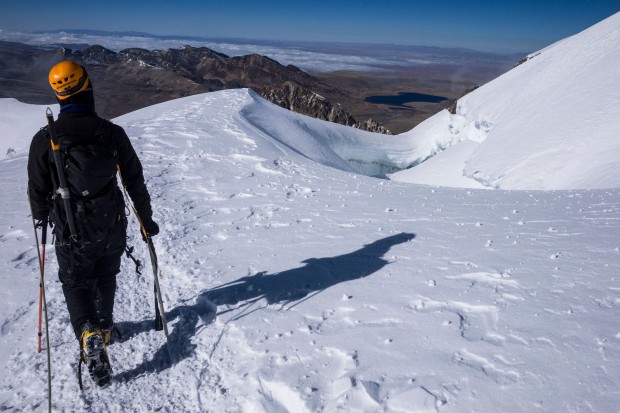
“You know nothing Jon Snow” Yes, I was in the middle of watching Game of Throne at that time. Of course it crossed my mind!
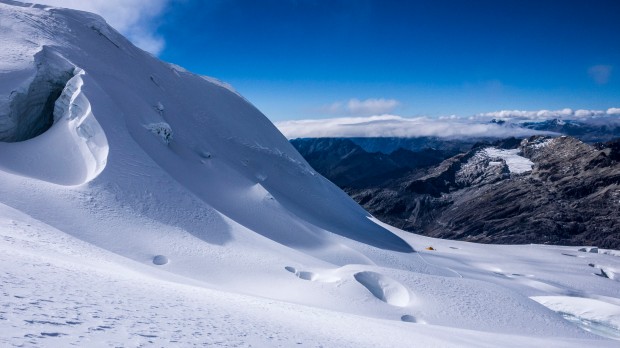
Going down and down and down
And then all of a sudden…
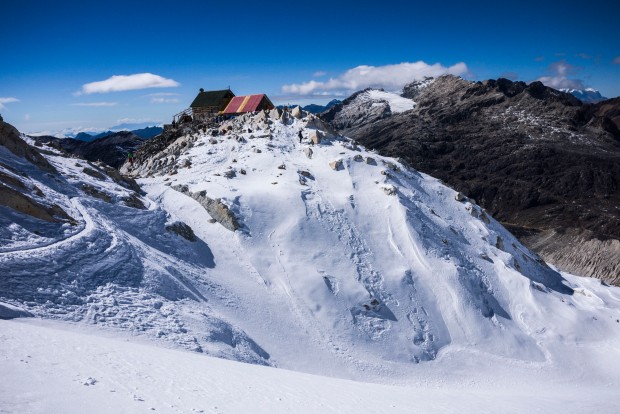
Back where we started (almost)
We had some lunch and a quick rest before heading back to the base camp and back to La Paz. As much as it was unreal to be standing on top of a 6088m high mountain, it was unreal to get back to civilization that quickly.
I have thought about this day quite often since then and still get shivers while reminiscing. One thing is for sure, this is a pretty addictive experience. Every time I go climb a mountain, however high it may be, there is always a moment (particularly right at the beginning, the hardest part) when I think “oh come on, why am I doing it again?” But this thought disappear as quickly as it came as soon as I get a bit higher, where it’s quiet, quiet enough to see animals wondering what you are doing there. And then I remember. And then you reach the summit, and it’s magical and you’re tired, but you’ve made it. Mountains are truly magical. It turns the worst food into a feast. Everything is more intense. You feel strong yet tiny and vulnerable at the same time. And there is that pride of being somewhere other people are not, because it is hard work to get to enjoy the divine luxury of slowlitude, à deux.




